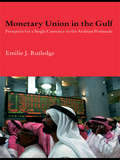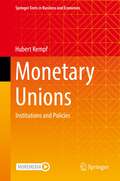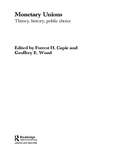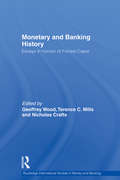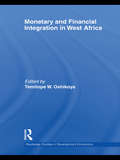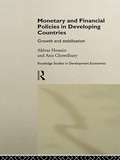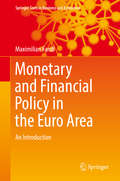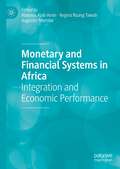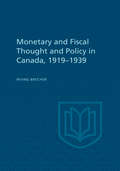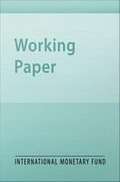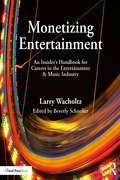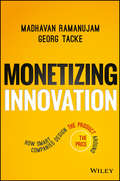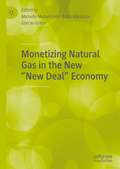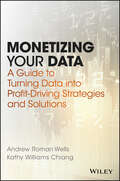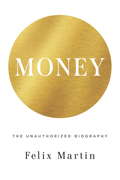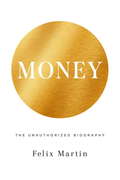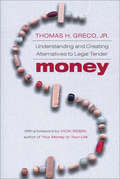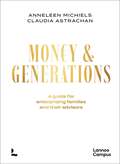- Table View
- List View
Monetary Transmission in an Emerging Targeter: The Case of Brazil
by Luis Catão Douglas Laxton Adrian PaganA report from the International Monetary Fund.
Monetary Union Among Member Countries of the Gulf Cooperation Council
by John Wilson Rina Bhattacharya Andrea Schaechter Van Can Thai Bright OkoguThe six member countries of the Gulf Cooperation Council (GCC)--Bahrain, Kuwait, Oman, Qatar, Saudi Arabia, and the United Arab Emirates--have made important progress toward economic and financial integration, with the aim of establishing an economic and monetary union. This paper provides a detailed analysis of the economic performance and policies of the GCC countries during 1990-2002. Drawing on the lessons from the experience of selected currency and monetary unions in Africa, Europe, and the Caribbean, it assesses the potential costs and benefits of a common currency for GCC countries and also reviews the options for implementing a monetary union among these countries.
Monetary Union in West Africa (ECOWAS)
by Paul R. Masson Catherine A. PattilloIn April 2000 six West African countries declared their intention to proceed to monetary union among the non-CFA franc countries of the region by January 2003, as a first step toward a wider monetary union including all the ECOWAS countries in 2004. The purpose of this paper is to evaluate whether a monetary union makes economic sense, to discuss the institutional requirements for successful monetary union and to consider how best the political momentum for a union can be channeled toward a fundamental improvement in underlying policies.
Monetary Union in the Gulf: Prospects for a Single Currency in the Arabian Peninsula
by Emilie RutledgeAt a time of momentous shifts in the balance of world economic forces epitomized by the current oil price boom, the weakening US dollar and the global credit crunch; the meteoric rise of the Arabian peninsula cannot be understated. Neither, therefore, can their planned monetary union. As key suppliers of the worlds oil and gas the Gulf states have
Monetary Unions: Institutions and Policies (Springer Texts in Business and Economics)
by Hubert KempfThis textbook explains the notion of monetary union, highlighting the key concepts, procedures, and challenges involved. The book is organized in three parts. In the first part, the reader learns about monetary issues, like definitions and typology of monetary unions, rationale of monetary unions, monetary policy, monetary institutional matters. The second part is devoted to fiscal matters and the interplay between fiscal and monetary policies, such as deficits, transfers, public debt sustainability issues, fiscal policy, policy mix. The last part focuses on other distinct but related issues, necessary to complete the union: banking and fiscal unions, structural adjustments in a monetary union. It ends with a chapter on the fate of monetary unions: how they develop, mature and sometimes dissolve.The book addresses students at undergraduate and graduate level, interested in a better understanding of international macroeconomics and monetary unions, as well as policy-makers, practitioners and economists in central banks, ministries of economics, economic institutions and banks.
Monetary Unions: Theory, History, Public Choice (Routledge International Studies in Money and Banking)
by Geoffrey E. Wood Forrest H. CapieThe Economic and Monetary Union (EMU) in which some members of the European Union have joined, has prompted much discussion of monetary union. Most of this discussion has focused on the immediate issues, such as prospects for the Euro and the possibility of expanding the Euro-zone. This book stands back and considers the relevant theory or what lessons might be drawn from other unions that have been formed in the past as well as looking at EMU directly.
Monetary and Banking History: Essays in Honour of Forrest Capie (Routledge International Studies In Money And Banking Ser. #62)
by Geoffrey Wood Nicholas Crafts Terence C. MillsForrest Capie is an eminent economic historian who has published extensively on a wide range of topics, with an emphasis on banking and monetary history, particularly in the nineteenth and twentieth centuries, but also in other areas such as tariffs and the interwar economy. He is a former editor of the Economic History Review, one of the leading academic journals in this discipline. Under the steely editorship of Geoffrey Wood, this book brings together a stellar line of of contributors - including Charles Goodhart, Harold James, Michael Bordo, Barry Eichengreen, Charles Calomiris, and Anna Schwartz. The book analyzes many of the mainstream themes in economic and financial history - monetary policy, international financial regulation, economic performance, exchange rate systems, international trade, banking and financial markets - where historical perspectives are considered important. The current wave of globalisation has stimulated interest in many of these areas as ‘lessons of history’ are sought. These themes also reflect the breadth of Capie’s work in terms of time periods and topics.
Monetary and Financial Integration in West Africa (Routledge Studies In Development Economics Ser. #81)
by Temitope W OshikoyaMonetary and Financial Integration in West Africa details the progress, challenges faced, and potential of the project intended to create a West African Monetary Zone (WAMZ) between Gambia, Ghana, Guinea, Nigeria and Sierra Leone. Given the trend towards regionalization of economic ties across the world, especially after the successful launch of the euro, a detailed analysis of the WAMZ is needed. As this is the first book on monetary and financial integration in Gambia, Ghana, Guinea, Nigeria and Sierra Leone, it is an essential read for anyone interested in economic development in West Africa, and indeed in Africa as a whole. This book is extremely well-researched, with detail on virtually all aspects of economic integration in the region; with issues ranging from the institutional details of integration, trade and financial market integration, to progress on convergence of macroeconomic fundamentals to the required payments system infrastructure. The book deploys solid empirical facts and sophisticated analyses to thoroughly defend its assertions. This collection is a valuable contribution and an excellent companion book for monetary economics or international economics classes as well as African development literature. It will provide students and researchers with an exciting chance to apply concepts of, for example, optimum currency areas, central bank structure or monetary policy approaches, to a real-world case of potential monetary union. Dr. Temitope W. Oshikoya and his collaborators have written the authoritative book on the subject of monetary union in the West African Monetary Zone. As is evident in the level of detail of the book, Dr. Oshikoya brings rich field experience from his role as Director General and CEO of the West African Monetary Institute. This book will be of interest to postgraduates and researchers in development economics; as well as policymakers, monetary authorities and development practitioners.
Monetary and Financial Policies in Developing Countries: Growth and Stabilization (Routledge Studies in Development Economics)
by Akhtar Hossain Anis ChowdhuryThe issue of economic development and monetary stability has produced one of the most passionate debates in economic literature. Yet, much of the evidence employed in this debate is contradictory. Monetary and Financial Policies in Developing Countries: Growth and Stabilization brings together diverse views on the subject within a coherent framework. The work includes: * a balanced assessment of empirical findings and their theoretical foundations on the role of money and growth * a discussion of financial liberalization reform in developing countries * an analysis of monetary policy as an instrument of economic stabilization * an examination of the monetary supply and demand process in developing countries * a study of the relationship between money, credit, the balance of payments, inflation and the exchange rate system * a reflection on market failures and the role of government.
Monetary and Financial Policy in the Euro Area: An Introduction (Springer Texts in Business and Economics)
by Maximilian FandlThis textbook provides a comprehensive overview of monetary policy, banking supervision and financial stability in the euro area. The author uses his professional experience in central banking to provide a thorough understanding of European economics and to explore how the monetary and financial system functions. The book takes into account the profound changes that resulted from crisis developments in recent years, such as the implementation of quantitative easing or the establishment of the Single Supervisory Mechanism (SSM). The author also invites readers to develop their thoughts on alternative policies to shape the monetary and financial system of the future. The textbook is tailor-made for intermediate courses in economics but will also appeal to those preparing a career in central banking or financial regulation.
Monetary and Financial Statistics
by International Monetary FundA report from the International Monetary Fund.
Monetary and Financial Statistics Manual
by International Monetary FundConsistency in the preparation and presentation of monetary and financial macrostatistics promotes comparability of data both within a country and across countries. The purpose of this manual is to offer International Monetary Fund guidelines for the presentation of monetary and financial statistics. The intention is that these guidelines will assist with the formulation and monitoring of monetary policy. The manual provides a set of tools for identifying classifying and recording stocks and flows of financial assets and liabilities; describes standard analytically oriented frameworks in which the statistics may be presented; and identifies useful aggregates within those frameworks.
Monetary and Financial Systems in Africa: Integration and Economic Performance
by Aloysius Ajab Amin Regina Nsang Tawah Augustin NtembeThis book provides an overview of the monetary and financial systems seen in Africa. The issues related to these systems are examined to help evaluate their effectiveness in fostering the development of African economies. Economic integration is extensively discussed to highlight variations between different parts of Africa and the specific challenges seen within certain regions. The impact of monetary unions, in particular the CFA franc zone, on economic activities is also explored.This book aims to outline how sustainable development can be achieved in Africa through well-developed financial and monetary institutions and policies. It will be relevant to students, academics and policy makers interested in African and development economics.
Monetary and Fiscal Policy Options for Dealing with External Shocks: Insights from the GIMF for Colombia
by Benedict Clements Daniel Leigh Enrique FloresA report from the International Monetary Fund.
Monetary and Fiscal Thought and Policy in Canada, 1919-1939
by Irving BrecherIn this careful and thorough study of a Canadian field which has been relatively untouched in recent years, Dr. Brecher records and comments on the development of monetary and fiscal thinking in Canada in the inter-war period, and its impact on public policy in the federal sphere. Examining Canadian opinion about economic theory during this time, the author draws on four fields of thought: that of government and other public officials; of businessmen, such as bankers, and their views on what should be done about the depression; of the "radical group", such as those prominent in the formation of the CCF and Social Credit parties; and of economists, prominent in the universities.Dr. Brecher points out in his preface that his inquiry is rooted in the conviction that the problems associated with cyclical fluctuations remain sufficiently complex to make an understanding of the developments of the twenties and thirties an indispensable condition for effective stabilization policy. He finds the twenties distinguished only in the superficial and imperfect diagnosis of and remedial suggestions for unemployment, made chiefly by a relatively small handful of thinkers associated with the Progressive and United Farmers movements, then emerging in the West. It was the thirties which, under the impact of the depression, witnessed the first real stirrings of careful economic analysis in cyclical terms, and of statistical techniques for measuring the value of annual productive activity and income receipts in the Dominion.The author has attempted to appraise the evolution of the Canadian policy of monetary and fiscal stabilization within the thought environment in which it was conceived and implemented, and on the basis of the standards set by modern income-employment theory.
Monetary and Macroprudential Policy Rules in a Model with House Price Booms
by Pau Rabanal Prakash Kannan Alasdai ScottA report from the International Monetary Fund.
Monetizing Entertainment: An Insider's Handbook for Careers in the Entertainment and Music Industry
by Larry Wacholtz<p><i>Monetizing Entertainment: An Insider's Handbook for Careers in the Entertainment and Music Industry</i> offers a thorough, guided exploration of the current state of the industry, with an emphasis on trends in copyright, digital streaming, and practical advice for developing a career as an artist, technician, or industry executive. <p>This book investigates a variety of topics within the entertainment and music industry, ranging from traditional and emerging business models to intellectual property rights to the creative destruction happening currently. The book strategically outlines the existing gaps that make being successful as an artist a dynamic interaction between creativity and business. <p>This book includes the following: <p> <li>An overview of the creative destruction process that has destroyed some of the old business models and created a number of career options. <li>A look at innovative, entrepreneurial career options. <li>A step-by-step examination for both creative and business professionals of the administrative and financial structures of the industry. <li>Detailed analysis of trends and topics shaping the current entertainment and music industry drawn from insiders' perspectives and other contemporary resources.</li> <p> <p>An accompanying website (www.routledge.com/cw/wacholtz), hosting case studies, videos, data, infographics, and blog posts on business models, is the perfect companion to this authoritative resource.</p>
Monetizing Innovation: How Smart Companies Design the Product Around the Price
by Madhavan Ramanujam Georg TackeSurprising rules for successful monetization Innovation is the most important driver of growth. Today, more than ever, companies need to innovate to survive. But successful innovation—measured in dollars and cents—is a very hard target to hit. Companies obsess over being creative and innovative and spend significant time and expense in designing and building products, yet struggle to monetize them: 72% of innovations fail to meet their financial targets—or fail entirely. Many companies have come to accept that a high failure rate, and the billions of dollars lost annually, is just the cost of doing business. Monetizing Innovations argues that this is tragic, wasteful, and wrong. Radically improving the odds that your innovation will succeed is just a matter of removing the guesswork. That happens when you put customer demand and willingness to pay in the driver seat—when you design the product around the price. It’s a new paradigm, and that opens the door to true game change: You can stop hoping to monetize, and start knowing that you will. The authors at Simon Kucher know what they’re talking about. As the world’s premier pricing and monetization consulting services company, with 800 professionals in 30 cities around the globe, they have helped clients ranging from massive pharmaceuticals to fast-growing startups find success. In Monetizing Innovation, they distil the lessons of thirty years and over 10,000 projects into a practical, nine-step approach. Whether you are a CEO, executive leadership, or part of the team responsible for innovation and new product development, this book is for you, with special sections and checklist-driven summaries to make monetizing innovation part of your company’s DNA. Illustrative case studies show how some of the world’s best innovative companies like LinkedIn, Uber, Porsche, Optimizely, Draeger, Swarovski and big pharmaceutical companies have used principles outlined in this book. A direct challenge to the status quo “spray and pray” style of innovation, Monetizing Innovation presents a practical approach that can be adopted by any organization, in any industry. Most monetizing innovation failure point home. Now more than ever, companies must rethink the practices that have lost countless billions of dollars. Monetizing Innovation presents a new way forward, and a clear promise: Go from hope to certainty.
Monetizing Insurance at Tr v
by Thales S. Teixeira Leandro Guissoni Samy DanaTrov is a disruptive startup in the insurance space ("insurtech"). It allows consumers to simply turn on and turn off insurance for each of their possessions on a mobile app with the swipe of a finger. Consumer love the simple, on-demand, single-item coverage product. However, the cost to acquire customers (CAC) for Trov is significantly higher than the total expected contribution margins (CLV) for the single item coverage insurance product that the company is known for. In light of this, what should the CEO of Trov to with the product? How can Trov monetize on-demand insurance?
Monetizing Natural Gas in the New “New Deal” Economy
by Michelle Michot Foss Anna Mikulska Gürcan GülenNatural gas markets have undergone momentous changes, worldwide. This book updates and expands on the dynamics, performance and forward path of expanding natural gas use in the US and worldwide, including international trade. It brings together major research themes and findings with recent updates and analysis of new trends and developments. It also explores many considerations for natural gas market development, such as the importance of infrastructure, transparent pricing, and institutional capacity. This book is unique in providing background on the full natural gas value chain as well as information and analysis that can foster scenario-building and decision-making. Of particular value are the lessons learned and demonstrated for those countries that aspire to build effective natural gas markets and to expand natural gas development and use.
Monetizing Your Data: A Guide to Turning Data into Profit-Driving Strategies and Solutions
by Andrew Roman Wells Kathy Williams ChiangTransforming data into revenue generating strategies and actions Organizations are swamped with data—collected from web traffic, point of sale systems, enterprise resource planning systems, and more, but what to do with it? Monetizing your Data provides a framework and path for business managers to convert ever-increasing volumes of data into revenue generating actions through three disciplines: decision architecture, data science, and guided analytics. There are large gaps between understanding a business problem and knowing which data is relevant to the problem and how to leverage that data to drive significant financial performance. Using a proven methodology developed in the field through delivering meaningful solutions to Fortune 500 companies, this book gives you the analytical tools, methods, and techniques to transform data you already have into information into insights that drive winning decisions. Beginning with an explanation of the analytical cycle, this book guides you through the process of developing value generating strategies that can translate into big returns. The companion website, www.monetizingyourdata.com, provides templates, checklists, and examples to help you apply the methodology in your environment, and the expert author team provides authoritative guidance every step of the way. This book shows you how to use your data to: Monetize your data to drive revenue and cut costs Connect your data to decisions that drive action and deliver value Develop analytic tools to guide managers up and down the ladder to better decisions Turning data into action is key; data can be a valuable competitive advantage, but only if you understand how to organize it, structure it, and uncover the actionable information hidden within it through decision architecture and guided analytics. From multinational corporations to single-owner small businesses, companies of every size and structure stand to benefit from these tools, methods, and techniques; Monetizing your Data walks you through the translation and transformation to help you leverage your data into value creating strategies.
Money
by Felix MartinFrom ancient currency to Adam Smith, from the gold standard to shadow banking and the Great Recession: a sweeping historical epic that traces the development and evolution of one of humankind's greatest inventions. What is money, and how does it work? In this tour de force of political, cultural and economic history, Felix Martin challenges nothing less than our conventional understanding of money. He describes how the Western idea of money emerged from interactions between Mesopotamia and ancient Greece and was shaped over the centuries by tensions between sovereigns and the emerging middle classes. He explores the extraordinary diversity of the world's monetary systems, from the Pacific island of Yap, where value was once measured by immovable stones, to the currency of today that exists solely on globally connected computer screens. Martin shows that money has always been a deeply political instrument, and that it is our failure to remember this that led to the crisis in our financial system and so to the Great Recession. He concludes with practical solutions to our current pressing, money-based problems. Money skips nimbly among such far-ranging topics as John Locke's disastrous excursion into economic policy, Montesquieu's faith in finance to discipline the power of kings, the social organization of ancient Sparta and the Soviet Union's ill-fated attempt to abolish money and banking altogether. Throughout, Martin makes vivid sense of a chaotic and sometimes incoherent system--the everyday currency that we all share--in the clearest and most stimulating terms. This is a magisterial work of history and economics, with profound implications for the world today.
Money
by Felix MartinFrom ancient currency to Adam Smith, from the gold standard to shadow banking and the Great Recession: a sweeping historical epic that traces the development and evolution of one of humankind's greatest inventions.What is money, and how does it work? In this tour de force of political, cultural and economic history, Felix Martin challenges nothing less than our conventional understanding of money. He describes how the Western idea of money emerged from interactions between Mesopotamia and ancient Greece and was shaped over the centuries by tensions between sovereigns and the emerging middle classes. He explores the extraordinary diversity of the world's monetary systems, from the Pacific island of Yap, where value was once measured by immovable stones, to the currency of today that exists solely on globally connected computer screens. Martin shows that money has always been a deeply political instrument, and that it is our failure to remember this that led to the crisis in our financial system and so to the Great Recession. He concludes with practical solutions to our current pressing, money-based problems. Money skips nimbly among such far-ranging topics as John Locke's disastrous excursion into economic policy, Montesquieu's faith in finance to discipline the power of kings, the social organization of ancient Sparta and the Soviet Union's ill-fated attempt to abolish money and banking altogether. Throughout, Martin makes vivid sense of a chaotic and sometimes incoherent system--the everyday currency that we all share--in the clearest and most stimulating terms. This is a magisterial work of history and economics, with profound implications for the world today.
Money
by Thomas H. Greco"Money" will set your mental gears spinning with fantastic ideas. This book explains the mysteries and realities of money in clear and accessible prose, and reveals the true workings, and alarming fragility, of our existing financial system. It also describes concrete and realistic actions that individuals, businesses, social service agencies, and governments can take to enhance productivity and purchasing power, to protect local economies from the ravages of globalization, and to strengthen the bonds of community. "Money" is a radical critique of our existing financial system, but also a practical and inspirational how-to manual for creating a vibrant and effective community currency system. A retired professor of business and economics, Tom Greco has spent twenty years studying community currency systems around the world. He helped establish the Tucson Traders currency in Arizona, and he has served as a consultant for many others. No pie-in-the-sky idealist, Greco offers a realistic vision of how healthy local economies can be supplemented with flourishing community currencies.
Money & Generations: A guide for enterprising families and their advisors
by Anneleen Michiels Claudia Binz AstrachanMon€y & Generations offers a compelling look at the complex interplay between family, business, and wealth.Mon€y & Generations offers a compelling look at the complex interplay between family, business, and wealth. It provides deep insights into the psychology of money in enterprising families, covering topics such as money scripts that shape individuals&’ relationships with money, setting dividends and compensation, providing financial education for family owners and stewards, and the role family offices play in protecting and growing family wealth. These themes are translated into practical strategies that support harmony and long term success across generations.

